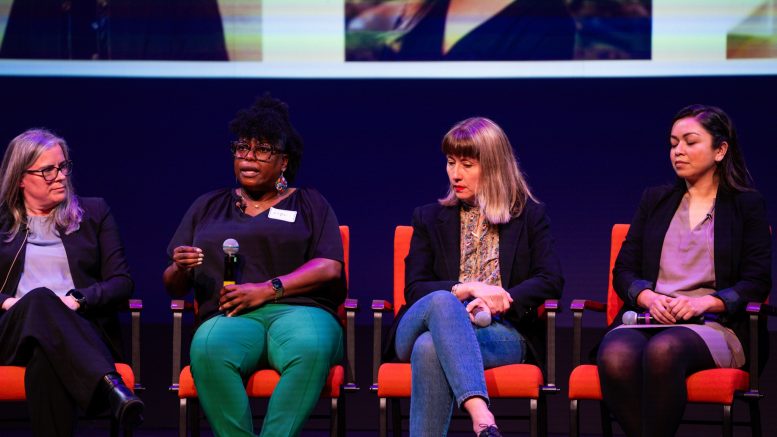Findings from the sixth Arts & Economic Prosperity (AEP6) study revealed
By Cristian Gonzalez
The sixth Arts & Economic Prosperity (AEP6) study revealed that the arts and culture sector generated $151.7 billion in nationwide economic activity in 2022.
The study, conducted by Americans for the Arts in partnership with 297 organizations across the U.S. and Puerto Rico, delved into the economic contribution of nonprofit arts and culture organizations and the spending patterns of audiences.
In Sacramento County, $241.7 million was generated by the arts and culture industry, supporting 4,343 jobs and $164.8 million in personal income in 2022. These figures were announced during an AEP6 press event March 15 at The Sofia, which brought together leaders in the local art community and creative economy to discuss the findings.
“As an artist, when I create, that’s like a very personal experience, but the impact of my work on the community — that’s the broader conversation,” said Jaya King, Sacramento-based mural and studio artist, who attended the AEP6 event.
Nonprofit arts and culture organizations were praised for employing and purchasing locally and actively supporting their communities.
“We’ve been around 150 years and we feel a sense of responsibility to furthering the arts and the community,” Kat Haro, director of marketing and communications at Crocker Art Museum, said. “So getting this data, figuring out how we can utilize that — capitalize on that — to help continue to make that argument is huge.”
According to the study, the arts and culture sector generated $73.3 billion in spending by organizations and an additional $78.4 billion in event-related expenditures by audiences nationally. This economic activity supported 2.6 million jobs and contributed $101 billion in personal income, generating $29.1 billion in tax revenue for local, state, and federal governments in 2022.
“The conversation is very beneficial,” King said. “Just so that you can literally know your numbers and grow as an individual artist or an organization.”
The study found that attendees of Sacramento arts and cultural events spent an average of $33.13 beyond the cost of admission, which includes purchases made at events such as concessions and merchandise. BIPOC (Black, Indigenous, and people of color) and ALAANA (African, Latino/a, Asian, Arab, and Native American) events saw attendees spending an average of $38.29 per person nationally.
“Arts experiences, they’re not like one time transactional moments, but rather, arts and culture. It’s part of our history and our heritage and our community,” Randy Cohen, vice president of research at Americans for the Arts, said during the event. “And you know, where we’ve been, where we are and where we’re going.”
Cultural activities also drive the visitor economy, with nearly one quarter of attendees traveling from outside Sacramento County to attend events within the county. According to the study, post-COVID audiences spent more per event but traveled less, indicating a shift toward supporting local events.
The study found that eventgoers had a strong sense of pride in community events, with 89% agreeing that the cultural activities or venues they attended were sources of neighborhood pride, and 86% indicating they would feel a sense of loss if these activities or venues ceased.
“The role of cultural centers is filling a void, a very natural void that we have, and a natural desire as human beings to come together,” Megan Van Voorhis, director of Convention and Cultural services for the City of Sacramento, said. “To understand, to learn, to exchange ideas, and to build a sense of community and belonging.”
More than half of attendees of Sacramento County events who were surveyed expressed that if Sacramento didn’t offer such events, they would have been willing to travel to a different community to attend similar ones. Haro spoke on the importance of offering opportunities to engage with local arts and culture.
“Anytime that you do that you are naturally expanding people’s capacity for empathy, people’s sense of humanity, and really understanding the wider world around them,” Haro said. “I think if you can’t empathize, then you can’t understand the people that you live with or that live around you.”
This story is part of the Solving Sacramento journalism collaborative. Solving Sacramento is supported by funding from the James Irvine Foundation and James B. McClatchy Foundation. Our partners include California Groundbreakers, Capital Public Radio, Outword, Russian America Media, Sacramento Business Journal, Sacramento News & Review, Sacramento Observer and Univision 19.




Be the first to comment on "Nonprofit arts and culture sector pumped $241.7 million into Sacramento County in 2022, $151.7 billion into national economy"